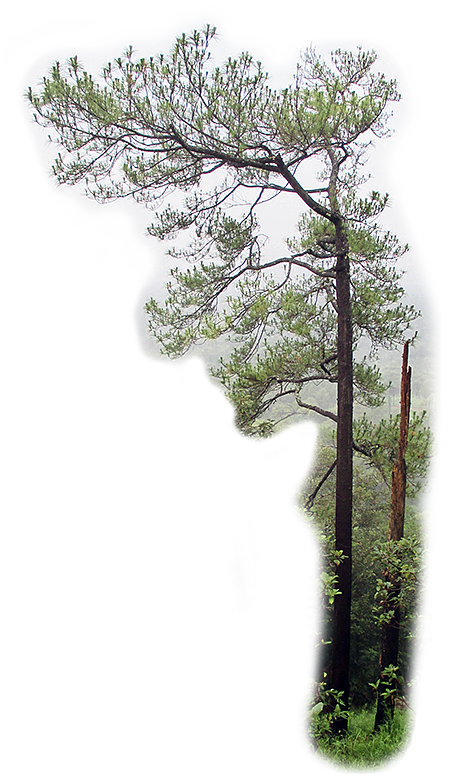
Kirirom Mountain
Mountainous Kirirom National Park (Khmer: Preah Suramarit Kossomak National Park) is a surprisingly unique landscape which stands in stark contrast to everyting else I have seen in Cambodia. Climbing up the only (pretty rotten) road and approaching a higher elevation, the secondary jungle below disappears and pine trees (pinus merkusii) cover the wide, hilly upper parts of Kirirom Mountain Plateau.
Pinus Merkusii
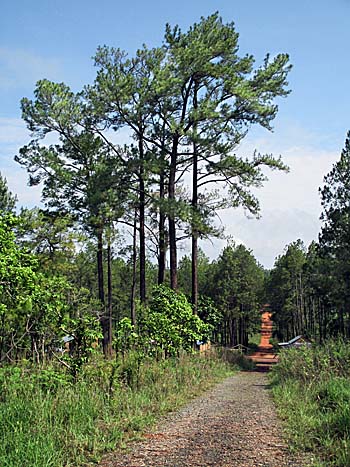
The high plateau of Kirirom Mountain is coined by wide forests of pine trees. Image by Asienreisender, 4/2015
The tropical temperatures drop considerably, and, after a rainy night, the foggy pine forests remembered me on the first glance to the landscapes of the Teutoburg Forest in northwest Germany. But, only for a few seconds. It's rather comparable to the mediterranean landscapes of Spain, south of France, Italy... The highest peak of Kirirom Mountain is 675m above sea level. The park comprises around 350km2.
Very, very few Westerners visit Kirirom National Park. It's rather a retreat for Khmers from Phnom Penh, what lies about 100km east and is by car easily accessible via NH4. South of Kirirom, separated by the national road, follows Bokor Mountain. West of Kirirom are the peaks of the Cardamom Mountains.
There is one main road, a paved one, which leads over some 16km to the top of a peak on which are the ruins of a former royal palace placed. The palace ruins are completely down, and no hint shows what it was before. Nearby is a visitor center and three booths who sell 'products' of the forest, plants above all, although I wouldn't wonder if they sell animals as well after request. The people who live here go frequently into the forests and take what they can use and sell; it's no secret that poaching happens on a regular base here as everywhere in Cambodia's 'protected' areas.
The Kirirom Mountain Massive
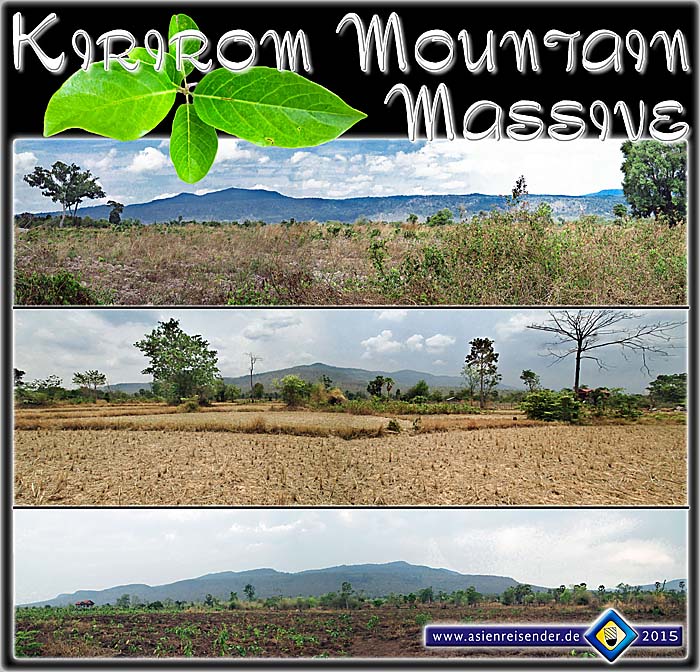
Different views on Kirirom Mountain / Kirirom National Park from the western side. Images and photocomposition by Asienreisender, 4/2015
Palace Peak and the Visitor Center
The visitor center is a small, run-down building with only one room. It was abandoned but open. A few old posters who thematize environmental protection are on the walls. From the rear side of the building one has a good overview over the next valley, on which ground lies a forest lake (Sras Srorng Lake).
The main road up to here has a number of side roads, mostly dirt roads. There are some more primitive wooden booths here and there. They sell also drinks, petrol in former Coca-Cola bottles and here and there some unattractive food of low quality. To get acceptable, means tasty and healthy food, is generally a problem in Cambodia; here it's advisable to bring some own food when planning to stay here for a time.
Sras Srorng Lake
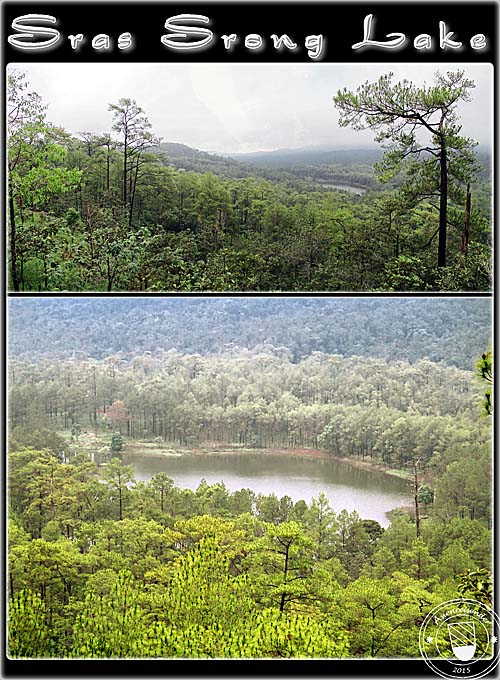
View from the visitor center over the wide pine forests of Kirirom National Park. In the valley down there lies Sras Srorng Lake. It's a pleasant walk down there. However, the landscape is crisscrossed by (some new) dirt roads and walking paths. The mountain plateau becomes developed. Images and photocomposition by Asienreisender, 2015
There are a few, apparently growing number of resorts in the National Park. They all are certainly overprized; a glance into newly built Pine Resort gave me the impression of an apparently high standard with western price level. This resort alone is spreading out over a considerable size with several different classes of rooms and bungalows, including a camping ground. The restaurant is the biggest building in the compound.
Degradation
The nature on Kirirom Mountain has clearly suffered extensive damage. The surrounding lowlands of the mountain are mostly deforested and changed into arable land. Parts of the logged forests regrow as secondary jungle. That doesn't look any better inside the park - the lower parts, who are dominated by tropical vegetation, have been logged once and regrow now. All the trees are young and of about the same size. That's at least how it looks along the roadside. Any road into the nature is an invitation for poachers and loggers.
At a certain altitude the pine trees start to dominate the nature. Over wide parts the mountain slopes are overgrown exclusively with these pines. Few of them look really old and big. Certainly the most valuable trees have been cut and sold. It's also remarkable that there are widely traces of forest fires (much arson, certainly). The ground looks partially black, the barks of the pines are darkened by soot and the ground vegetation is very young and just recovering. I noticed three fire brigade vehicles, one at the entrance of the park, two more in the pine forests.
View from Antenna Peak
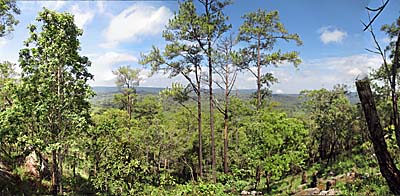
View over Kirirom Mountain Plateau from the peak with the four antenna towers. One of the workers (an engineer) approached and offered me to climb up on one of the antennas ladders for 5 US$. He also would knew more places in the park and would bring me there for 10 US$. All what he told me was contradicting and didn't make much sense. He had but only one thing in mind. Practically any talk with a Cambodian turns immediately into a sales talk. Image by Asienreisender, 2015
Additionally to the robbery of the nature there are bigger building sites in the 'protected' park. Extensive buddhist temples spread out in the nature; one is brandnew, another under construction and a third one, which seems to become quite bombastic, is in an early state. They eat considerable space and spoil the nature. The construction activities are dirty and noisy. It attracts more people, and where (Khmer) people go, sit, stand, they drop rubbish. Near Sras Srorng Lake is one of the big new temple sites, where logging happens all around to build more and more houses for the monks. Along the nearby stream the banks are all recently logged for the sake of new restaurant shacks. Some rapids there are an attraction for tourists and constitute a business opportunity. The site looks terrible and although the place is not yet finished, plastic rubbish is spread all around already. These buddhist monks are usually not any better than the average people.
New Settlement
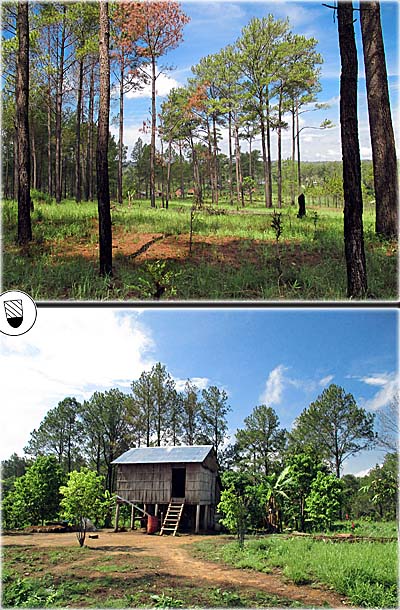
Behind the trees (upper image) runs a new dirt road. At both sides are shacks of the kind on the lower photo. Some are build more solid with pine wood. I don't know why these people settle in the park, but they mean a permanent impact on the nature. People who live in the forest live from the forest. Their dogs don't do any good for the animals here. Once a new settlement is established, it permanently grows bigger... Images and photocomposition by Asienreisender, 2015
Up on the mountainous, rolling high-plateau I found another new village along a new dirt road. All the simple houses were built with pine wood. I don't know what these people actually do there, dwelling in the park. Certainly any Cambodian who lives up there takes from the nature what he can use. With them come many dogs, who go hunting in the surroundings and kill the animals they get. The direct surroundings and gardens of the verymost Cambodians look swinishly dirty - they throw all their rubbish literally out of the windows. Plastic accumulates. That's not any better here than anywhere else in the country.
Khmer visitors from Phnom Penh visit in groups or families Kirirom Mountain at weekends. They make parties here and buy from the local dwellers the 'products' of the forest: firewood, (seldom) flowers, animals, meat...
The Park's Entrance Gate
Tthe park's entrance is a few kilometers south of the village of Traeng Trayueng at the NH4. A wooden booth with a bar to close the access road is placed there. A few half-naked bandit-like looking rascals are waiting there for arrivals. They demand from foreigners 5 US$, the precious Khmers pay either nothing or maximal a tenth of the price (50 US$ cents, or 2,000 riel, no entrance fee sign there to see); the Khmer Rich come in for free by all means, for they own the country and the guards wouldn't dare to cash them. The money is certainly not for protecting the nature. It's partially for the semi-guards themselves (who are not to recognize as anyhow official), partially it goes the hierarchy upwards via a superior to higher circles. The highest circles in Cambodian society, the Khmer Rich, don't waste money for natural protection. They make fortunes by butchering it as fast as possible and to sell the country out to international investors, who are themselves all but timid to prey on the nature wherever they can. By the way: the semi-guards didn't offer me any ticket, so there is not even the pretence of an organized management where the money flows to.
This entrance with an asphalt road is the only official one into the park. The road here has been built in the 1940s already. The name 'Kirirom' has been given by the then Khmer king Norodom Sihanouk, the dubious, excentric musical king who pacted with Pol Pot's Khmer Rouge. Kirirom means 'happiness'. The king then let build a new palace up there in the cool climate for his pleasure. There were also plans for a second hill station (the only one in Cambodia was on Bokor Mountain). Soon later, though, the place got abandoned because the Khmer Issarak guerilla fighters occupied the mountain. Later it became a stronghold of the Khmer Rouge until 1996. Three years before, in 1993, it was declared a national park.
Chambok Village
Following the dirt road which leads along the mountain's eastern slopes, one passes along a few Cambodian peasant houses (Chambok village) and ends finally up in secondary forest. A lot of smaller tracks lead into different directions. It would be kind of an expedition to try to find a way up into the National Park; I am pretty sure it's possible to go there, but one has to be careful not to get lost as a nonlocal.
Cambodian Shophouse
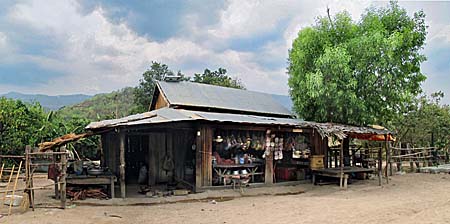
A typical rural Cambodian dwelling with a neighbourhood shop in Chambok Village at the foot of Kirirom Mountain. Image by Asienreisender, 2015
Back along the dirt road in Chambok Village there are some homestays. They have no names but numbers. I stayed for a night in homestay 26. A rough Cambodian wooden house on poles with a thin mattress on the ground and a naked light bulb fed by a car battery. A tiny toilet and bathroom combination outside for the whole family. The house and toilet were inside very clean, and I felt safe although I couldn't lock the door. Kids, cattle, fowl, all played around in the evening. Peasants sitting together, chatting. No din.
Conclusion
The protective status of Kirirom National Park means a delay of the destruction of the natural habitats. Not more. Poaching has been rampant here in recent years. The last traces of a tiger have been seen twenty years ago, in 1995. Rough Guide (2008) writes there were still elephants and leopards around, but probably not. Along the nearby NH4, the most murderous road in Cambodia, were years ago a number of restaurants who sold Pangolin meat. All the animals who can get sold are under severe pressure, and who pays a bribe can take what he/she wants - it's just a question of the price. Cambodia is clearly a neoliberal pattern state - there is no society, only individuals who meet on markets. For wildlife there is a market, so... let it go. The few rangers there were, even if they would try to do a serious job, far to weak to control the area.
The Destruction of Kirirom Mountain
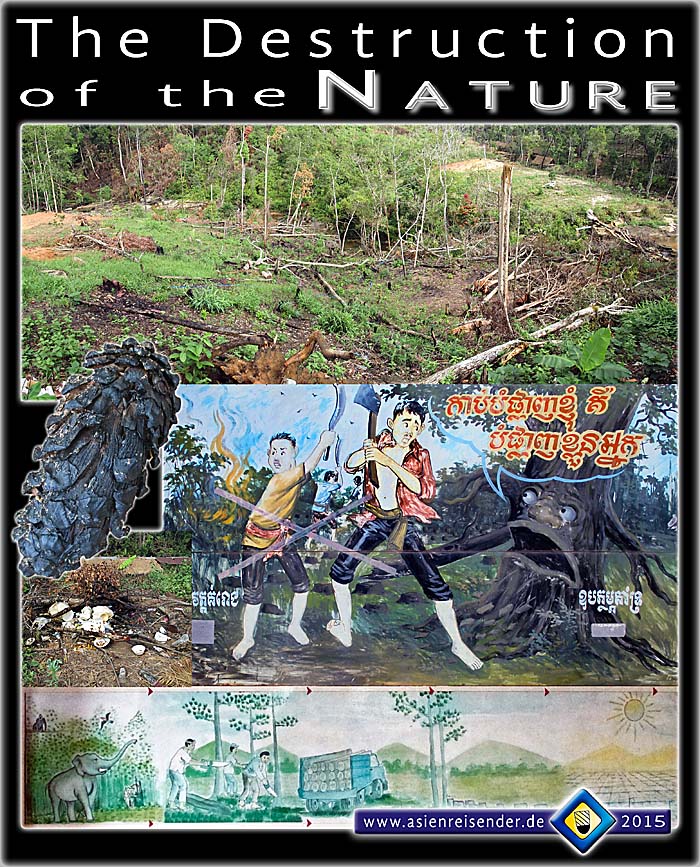
Deforestation and the destruction of all natural habitats in Cambodia is proceeding rampant. The Cardamom Mountains are the last great, consistent forested area in Cambodia. It suffered already heavily, and more heavy impact is planned or ongoing.
The first image of the collage shows what buddhist monks do to the nature. Logging the banks of a stream for more houses, shops and restaurant booths. More big temples are under construction in the park, for whose parts of the forest get cut. Organized religion is nothing but big business. As any business, it has to grow, grow, grow... The small photo under the fir cone shows plastic rubbish left by people who came into the nature and having food. It's directly next to the new temple near Sras Srorng Lake.
The painting middle-right is a poster in Chambok Village, warning the villagers of logging and causing arson. It's too late already - around the park and in the lower areas of the park the forest has been destroyed already and is now partially regrowing as secondary jungle. However, the animals who lived here lost their habitats and many of them won't come back. Also many plants get extinct after the destruction of whole areas. By the way: the villagers are a smaller part of the problem. Abettors from outside cause in many times the villagers to butcher the nature and pay them for and equip them with tools like chain saws.
The image below is part of a (yellowed) poster in the visitor center of the park. It describes the process of logging and what follows. The visitor center is neglected and the little bit equipment inside is (many) years old.
Images and photocomposition by Asienreisender, April 2015